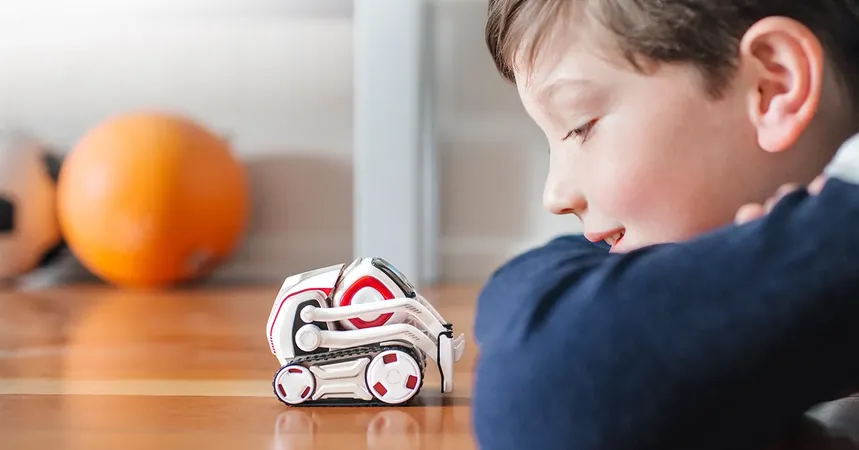
Unlocking the Mystery: How Robots Can Become More Than Just Machines
2025-07-14
Author: Emma
Robots Are Everywhere—But Can They Fit In?
In today's world, robots are becoming part of our daily lives, popping up in hospitals, homes, workplaces, and classrooms. But a crucial question lingers: can these machines truly integrate into our social world? Groundbreaking research from the University of East Anglia (UEA) suggests that they can—given the right approach.
Cozmo: The Robot That Thinks Outside the Box
To explore this concept, researchers studied a small, box-shaped robot named Cozmo, which doesn't resemble the humanoid machines of sci-fi fame. Despite its simple design, Cozmo can move, react, and engage. The research team aimed to discover whether individuals could see Cozmo as more than just a robot and what would facilitate this perception.
Playing With Robots: A Game Changer
In a compelling study involving over 100 participants, half interacted with Cozmo through a social game, while others performed mechanical tasks like moving the robot. The results were striking. Those who played with Cozmo began to see it as a social entity, attributing agency to its decisions and perceiving its actions as similar to human behavior.
The Power of Temporal Binding
This phenomenon was linked to a psychological concept known as "temporal binding." This occurs when individuals perceive the time between cause and effect as shorter, suggesting a sense of agency. The researchers were curious: would this effect apply to robots? Miraculously, it did—but only when robots were introduced in a social context.
When Robots Feel Sentient
Lead researcher Dr. Natalie Wyer emphasizes that the context is vital. Merely being near a robot isn't sufficient; it must exhibit a semblance of independent thought. According to Dr. Wyer, "When people interact socially with a robot, they begin to perceive its actions more like they would those of a human." This cognitive shift allowed the binding effect to manifest, leading participants to see Cozmo’s actions as intentional.
The Importance of Social Connection in Robotics
This research unveils a profound aspect of human psychology: our inherent need for connection. When a robot exhibits social behaviors, it activates familiar mental pathways that promote trust and warmth. This aspect is crucial, especially in settings like elder care or customer service, where robots serve not just as tools but as parts of human interaction.
Looks Aren't Everything—It's All About Behavior
Interestingly, Cozmo doesn’t resemble a human at all—no face, arms, or complex voice. Yet participants began to attribute human-like traits to it after just a simple social interaction. This highlights that while appearance matters, behavior and context play a far more significant role in shaping our perceptions.
A Shift in Robot Design Philosophy
The implications for future robot design are significant. Rather than focusing solely on human-like features, engineers might prioritize how robots behave in social interactions. The study, published in the Journal of Experimental Psychology, is a pioneering exploration into how humans can extend the concept of agency to robots, even those that lack a human-like facade.
A Playful Future Awaits Robots and Humans
So what does that mean for our technological future? The path to acceptance of robots as teammates, coworkers, or helpers may be simpler than we think. A quick game or social interaction could be the key to transforming cold robots into warm companions. As robotic roles expand in our lives, a little playfulness could foster connections that lead us to see them as more than mere machines.









 Brasil (PT)
Brasil (PT)
 Canada (EN)
Canada (EN)
 Chile (ES)
Chile (ES)
 Česko (CS)
Česko (CS)
 대한민국 (KO)
대한민국 (KO)
 España (ES)
España (ES)
 France (FR)
France (FR)
 Hong Kong (EN)
Hong Kong (EN)
 Italia (IT)
Italia (IT)
 日本 (JA)
日本 (JA)
 Magyarország (HU)
Magyarország (HU)
 Norge (NO)
Norge (NO)
 Polska (PL)
Polska (PL)
 Schweiz (DE)
Schweiz (DE)
 Singapore (EN)
Singapore (EN)
 Sverige (SV)
Sverige (SV)
 Suomi (FI)
Suomi (FI)
 Türkiye (TR)
Türkiye (TR)
 الإمارات العربية المتحدة (AR)
الإمارات العربية المتحدة (AR)